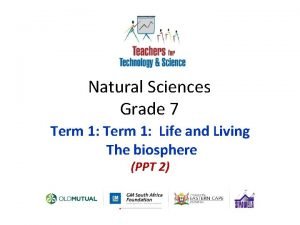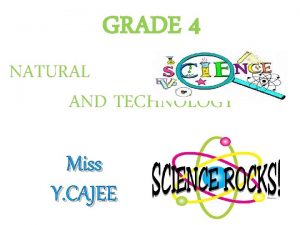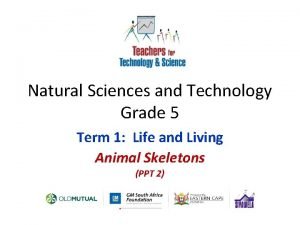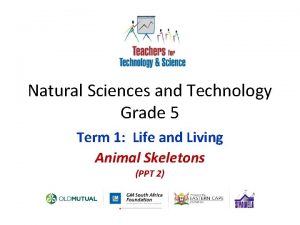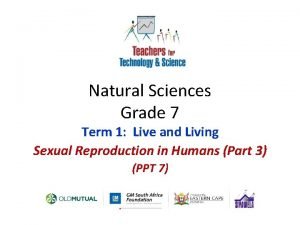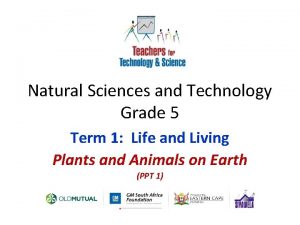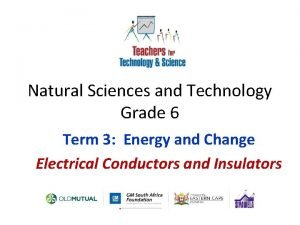Natural Sciences and Technology Grade 6 Term 3














- Slides: 14

Natural Sciences and Technology Grade 6 Term 3: Energy and Change Electrical Conductors and Insulators

Topic 2 Electrical Conductors and Insulators and Reinforcing Conductors Natural Sciences and Technology - Grade 6

Important facts about insulators wear gloves • Materials that do not allow electricity to pass through them, are called electrical insulators. • A few examples are rubber, plastic, wood, ceramic and glass. • An electrician must wear rubber gloves to protect himself/herself from shocking. Natural Sciences and Technology - Grade 6

Electricity pylons Natural Sciences and Technology - Grade 6

Electricity pylons • Electricity does not flow down the pylon, because the pylons have ceramic or glass insulators to support the overhead power lines. • If electricity flowed down the pylon, people or animals touching the pylons would be electrocuted. • The ceramic colourful caps that hold the wires of power and telephone lines are good insulators, because it does not conduct electricity. Natural Sciences and Technology - Grade 6

Electrical cords The plastic covering the electrical cords is an insulator that prevents people from getting shocked. Natural Sciences and Technology - Grade 6

Types of insulators 1. Glass insulators • It insulates the electrical wires they carry, so that electricity (or telephone calls) do not all leak into the pole and into the earth. • It would be impossible to transmit electricity to homes and businesses without insulators. Natural Sciences and Technology - Grade 6

Types of insulators • Smaller glass insulators are used on the circuits of telephones and telegraphs. • Larger glass insulators are used for electrical (power supply) wires. Natural Sciences and Technology - Grade 6

Types of insulators 2. Heat insulators Natural Sciences and Technology - Grade 6

Types of insulators (Heat insulators) • If you put clothes on, it warms the body and keeps the heat in. • Insulating a house is actually a very good idea, because the more heat insulation you have: - the less energy escapes; - the lower your fuel bills; - you help the planet in the fight against global warming. Natural Sciences and Technology - Grade 6

Types of insulators 3. Thermal insulators • Heat insulation in ceiling. Natural Sciences and Technology - Grade 6

Types of insulators (Thermal insulators) Natural Sciences and Technology - Grade 6

Types of insulators (Thermal insulators) • Wall insulation of a wooden structure. Natural Sciences and Technology - Grade 6

Types of insulators (Thermal insulators) • It keeps warm air inside your home. • Thermal insulation in the ceiling and wall structures of a building have the following advantages: - It prevents cold or hot air escaping from the interior room to the outside. - Less heat enters or escapes which is efficient for cooling and heating systems. - Heat from exterior building walls, which capture the sun’s heat energy, cannot be transmitted. Natural Sciences and Technology - Grade 6
 Grade 6 natural science term 4
Grade 6 natural science term 4 Natural science and technology grade 6 term 3
Natural science and technology grade 6 term 3 Grade 7 natural science term 1 notes
Grade 7 natural science term 1 notes Earth and beyond grade 7
Earth and beyond grade 7 Natural science grade 7 term 3
Natural science grade 7 term 3 Natural science tok
Natural science tok Natural science and technology grade 6 term 1
Natural science and technology grade 6 term 1 Natural science grade 6 term 4
Natural science grade 6 term 4 Formal assessment tasks grade 4 term 1
Formal assessment tasks grade 4 term 1 Animal skeletons grade 5
Animal skeletons grade 5 Properties of materials grade 7 powerpoint
Properties of materials grade 7 powerpoint Natural science grade 7 matter and materials
Natural science grade 7 matter and materials Animal skeletons grade 5
Animal skeletons grade 5 Natural science grade 7 term 3 notes
Natural science grade 7 term 3 notes Grade 5 natural science term 1
Grade 5 natural science term 1


